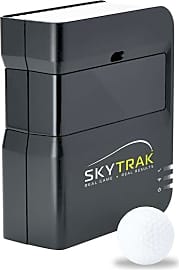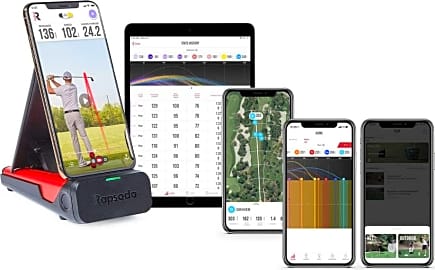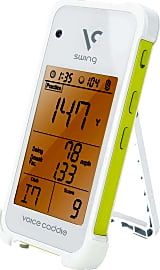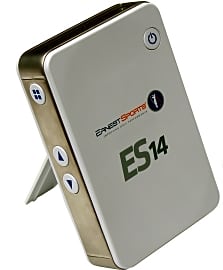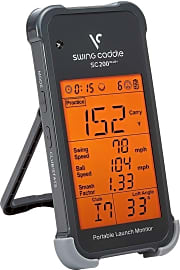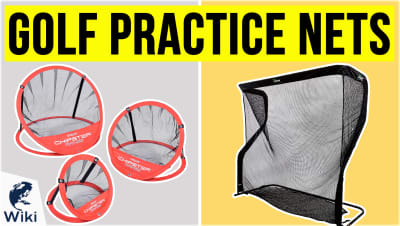The 9 Best Golf Launch Monitors

This wiki has been updated 37 times since it was first published in December of 2016. Whether you're practicing in the garage, hitting balls at the range, or playing on a links course, having access to accurate data can help you understand your carrying distances, improve your swing, and cut strokes off your game. Using radar or a system of cameras, a golf launch monitor can track speed, angle, and even spin rate, and use that information to calculate relevant statistics. When users buy our independently chosen editorial selections, we may earn commissions to help fund the Wiki.
Editor's Notes
November 12, 2020:
With this update, we searched for new models to add to this list, but found there were relatively few changes in the field. Furthermore, a number of the new additions to the marketplace appeared to be of questionable quality, though there were a few we felt were worthy of inclusion. Also of note, since these all offer fairly similar features, the main determining factors we used in deciding how each of these stacks up to the others were accuracy and value. That said, any stand-out capabilities, like the course simulation of the Garmin Approach G80, were definitely taken into account.
In terms of accuracy and precision, the SkyGolf Skytrak comes the closest to the high-end models used by professionals and teachers to analyze shots. However, it is very expensive, and it's likely that many people wouldn't be willing to spend that amount on a launch monitor. For something at a more reasonable price, the FlightScope Mevo gives impressively accurate readouts, though if you're looking for something predominantly for indoor use, the Voice Caddie SC200 Plus+ may be a better option, especially if you'll be practicing in a tighter space. Keep in mind, though, if your main goal is to improve your game, you may get just as much benefit from a swing analyzer, which you should be able to get for considerably less money than even a mid-range launch monitor.
As mentioned before, a few options have some interesting software features, like the Garmin Approach G80, which has over 40,000 courses programmed into it, and the Rapsodo MLM, which has interactive games that take advantage of your phone's GPS. While these are generally not as immersive as a dedicated golf simulator, they add a bit of extra functionality and contribute to the overall value. The SkyGolf Skytrak can actually function as a very impressive simulator, though it requires a lot of expensive add-ons, like a net, mat, and additional software package.
April 18, 2019:
Guessing on the golf course is never a good idea. If you're going to hit the green in regulation, you must have a good idea of how far your shots will go, and preferably, how they'll be spinning as they get there. All told, the SkyTrak is the standard by which may others are judged. It's photometric, which means it uses cameras rather than radar, and is the most accurate of anything that isn't extravagantly costly. That said, it is still considerably pricier than the other options, but if you can afford it, it's the one to get.
But a lot of golfers aren't keen on shelling out quite that much, which makes sense; you may be better served by spending some of that on few pro lessons. If you're looking to spend a more reasonable amount, the Garmin Approach G80 is a relatively new device that combines a launch monitor with the GPS functionality that the company is famous for. It's one of the very few all-in-one devices that can both track your swing as well as simulate actual golf courses, which makes practicing not only more fun, but also more effective and realistic. At an even lower price you'll find the Voice Caddie SC200, which doesn't have many bells and whistles, but is a surprisingly accurate option. If you already have a golf GPS or you just don't need that functionality, this may be the one for you.
SC100 and the Ernest ES12 are both entry-level options that have even fewer features than the rest. As such, they may not be satisfactory as a golfer's only launch monitor solution, but they can help to legitimize your practice sessions in a pinch. The SC300, Mevo, and Ernest ES14, on the other hand, are billed as mid-level devices, and they claim to offer far-expanded statistics and increased accuracy. Keep in mind, though, that these radar-based units work better when they have larger empty spaces around them while you're hitting balls. They can be used indoors, as long as your practice space is relatively large, though they tend to be much more accurate outside.
Special Honors
Foresight Sports GCQUAD For those looking for professional-grade precision and accuracy and are undeterred by a high price, the four-camera imaging system delivers detailed metrics on launch angles, carry distance, and with the purchase of the club add-on, just about anything you could want to know about your swing. It's made from shock mounted diecast aluminum, making it sufficiently durable, and it functions well both indoors and outside. foresightsports.com
How Launch Monitors Work
Ultimately, every monitor provides a host of data that you can use to pinpoint holes in your game.
Radar. High speed cameras. Complicated algorithms. All marvels of modern technology, the pinnacles of millennia of human tool development, things that previous generations would likely condemn as witchcraft were they to see them firsthand.
And we use them to improve our golf swings.
All of that state-of-the-art tech is used in a golf launch monitor, analyzing enough information to navigate the space shuttle, but using it instead to figure out the hitch in your swing.
Some monitors use Doppler technology — the same kind your local weatherman uses — to analyze the full flight of your ball after you hit it. They then use the flight information of the ball to extrapolate how you struck it, exposing any flaws in your mechanics.
This technology literally evolved from the kind the military uses to track missiles, so show some respect.
Other models use high speed cameras that inspect the first couple feet of the ball's trajectory. They take numerous pictures during this time, allowing the monitor to record things like ball velocity, club angle, spin rates, and more. This gives them all the info they need to tell what the full flight of the ball would be, and where you'd end up on the course.
Ultimately, every monitor provides a host of data that you can use to pinpoint holes in your game. What data they provide varies by model, but chances are any monitor will give you plenty of information to start rebuilding your swing.
How A Launch Monitor Can Help You Shave Strokes Off Your Game
Launch monitors are impressive tools, but that's all they are — tools. Don't expect one of these to immediately turn you into Jordan Spieth in a single afternoon. Still, if you've struggled with your handicap, these machines may help you identify weaknesses that the naked eye had previously missed.
With that in mind, most experts would recommend that you use one under the watchful eye of a swing coach or course pro. You may be overwhelmed by information, or find yourself focusing on data points that aren't really that important.
If you're not getting much distance on your drives, it may be due to an inability to generate speed off the tee.
The first way a monitor can help you occurs long before you ever set foot on a course. You can use one when you're getting fitted for clubs to ensure that your sticks are matched to your swing. This gives you an immediate leg up on the competition, allowing your club head to square up on the ball nearly every time without requiring swing correction.
One of the most important data points to consider is launch speed. Simply put, the harder you hit the ball, the further it's likely to go (provided you don't hit it directly at a tree or a water hazard, of course). If you're not getting much distance on your drives, it may be due to an inability to generate speed off the tee. This gives you something to work on with your coach.
You'll also be able to see your launch angle, which will determine how high the ball will fly once it's in the air. A ball hit hard and at a good angle will get you to the green in fewer strokes (which, of course, will put more pressure on you not to choke on that putt). If you're hitting the ball too high or too low, the monitor will reveal it, and then it's up to you to correct it.
However, be careful how much emphasis you place on each particular swing. Remember, one swing equals one data point — nothing more. You're looking to see what your average readings are on your normal swings, so don't go crazy over-correcting after every stroke.
And if it turns out you can't correct your swing, here's an equation you can use to still get the most out of your monitor: fun = swing + booze/time.
What To Look For In A Launch Monitor
While just about any monitor, if used properly, can improve your game, that doesn't mean that they're all created equal. Below are a few things to keep in mind before you buy one, so that you get the most bang for your buck.
Of course, the downside is that owning one leaves you with one less excuse as to why you can never break 80.
First off, it helps to know if there are any particular aspects of your game that you're most interested in working on before you commit to a particular model. For instance, if you're curious about how much spin you're putting on your drives, make sure you get a unit that measures spin rate.
Next, think about where you'll be using it. If you're taking it out on the course or the range, then a Doppler model might be your best bet. If you have limited space to swing or you practice indoors, you'll likely want a high speed camera unit instead.
Beyond that, it's all about what bells and whistles you want (and are willing to pay for). Some measure things like barometric pressure and other weather variables, which is great if you're trying to determine what time of day is best for your game. Others can communicate with your smartphone, allowing you to analyze your data at any time, like in a boring meeting or during one of your kid's dance recitals.
Regardless of which unit you choose, having a launch monitor will bring you one step closer to the perfect swing. Of course, the downside is that owning one leaves you with one less excuse as to why you can never break 80.



